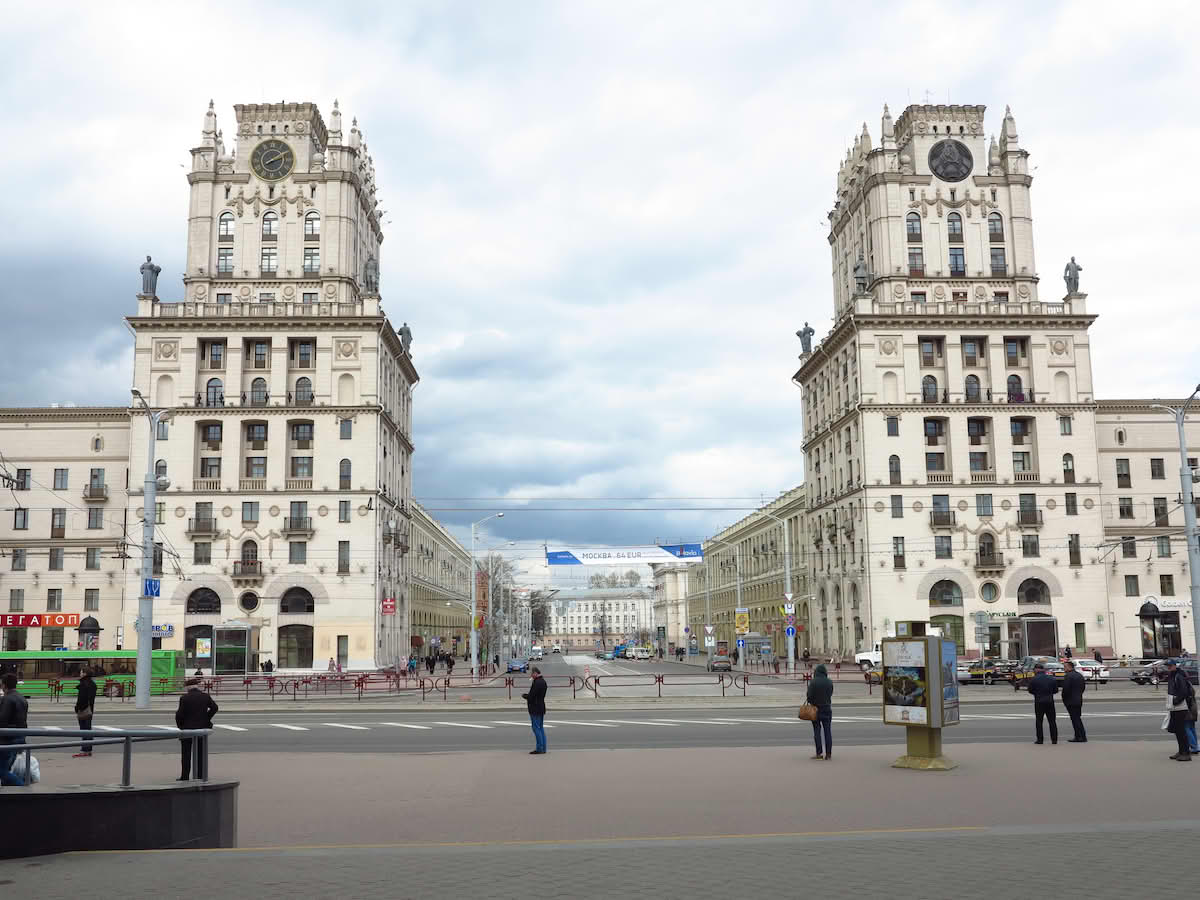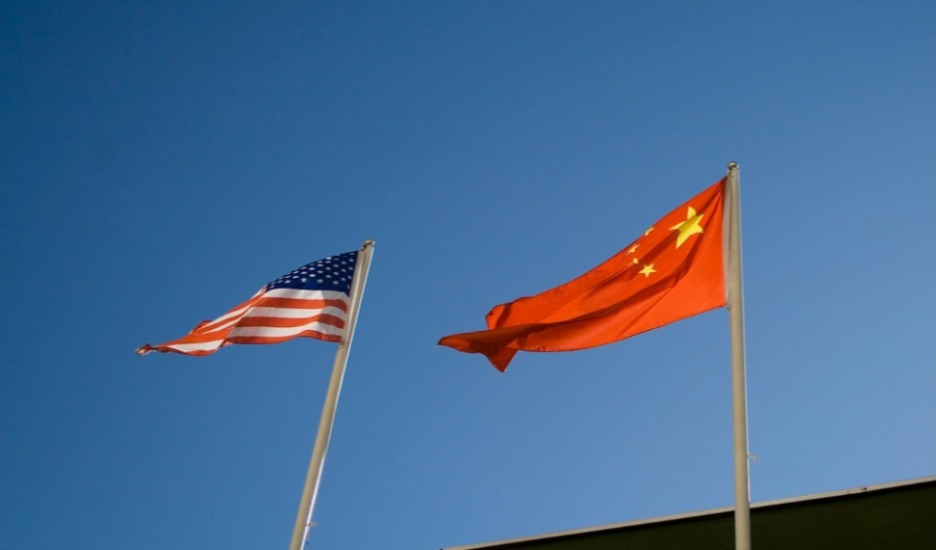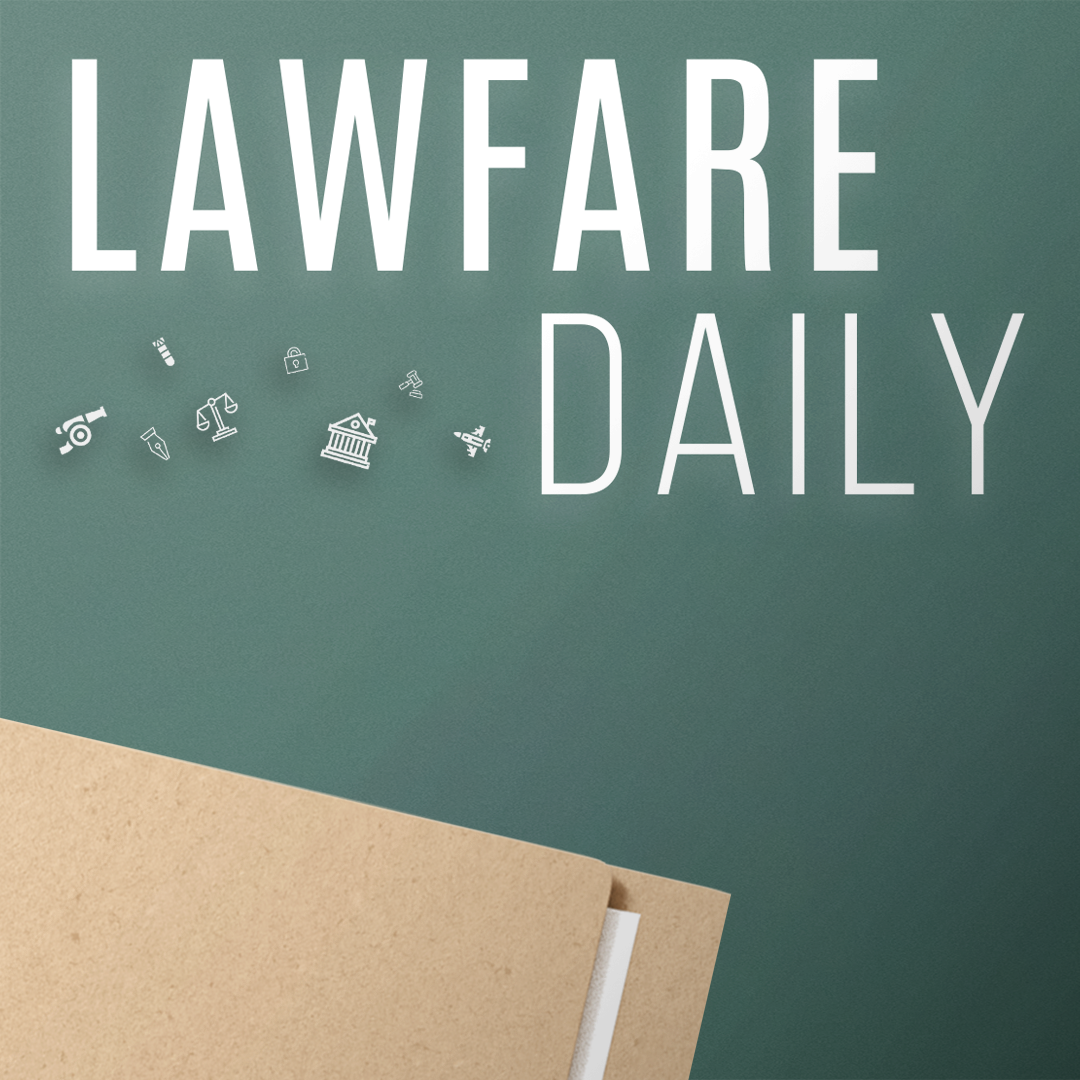What Washington Wants from Minsk
The Lukashenka regime wants sanctions relief for freeing political prisoners. But what’s in it for the Trump administration?

Published by The Lawfare Institute
in Cooperation With

A big, beautiful deal took place in Minsk last month. Following U.S. envoy Keith Kellogg’s visit on June 21, 14 Belarusian political prisoners were released. Only now are details beginning to emerge—including the fact that parts of the negotiations reportedly happened over vodka, as John Coale, Kellogg’s deputy envoy on Ukraine, shared in a recent POLITICO interview.
This is a rare moment when everyone seems to be pleased—the Lukashenka regime, the democratic opposition in exile, and the U.S. administration. “Thank you, President Trump,” said newly freed Belarusian dissident Siarhei Tsikhanouski, a message of gratitude that was quickly amplified on President Trump’s Truth Social.
In turn, Lukashenka treated the American delegation to his own vodka brand and toasted to Trump. Kellogg’s visit to Minsk and the resulting release of political prisoners was an unexpected turn given Washington’s recent retreat from a democratic support agenda. Kellogg traveled to the Belarusian capital to engage directly with Lukashenka, the Belarusian autocrat currently under U.S. sanctions and recognized by an actual act of Congress as illegitimate. The U.S. delegation sought to explore whether Lukashenka might play a role in facilitating the stalled peace talks between Russia and Ukraine.
Ahead of the visit, it was not obvious what role Lukashenka—who is seen in Ukraine as a puppet of Vladimir Putin’s—might plausibly play. And yet Kellogg showed up. And then a bunch of prisoners were released.
The entire episode left a lot of people scratching their heads and wondering: What’s going on here?
From the Belarusian regime’s side, the answer is fairly clear. Lukashenka is seeking a relaxation of sanctions and the restoration of international contacts, as the regime has been isolated by the European Union and the U.S. due to human rights abuses against its own population since 2020 and its role as a launchpad for Russia’s war on Ukraine. Several EU countries voluntarily recalled their ambassadors, while Belarus expelled Western diplomats and drastically reduced embassy staff. Most Western states refused to recognize Lukashenka’s legitimacy and declined to present credentials. One rare exception was Switzerland, which secured the release of its imprisoned citizen, Natallia Hersche, after discreet diplomacy and the symbolic gesture of presenting credentials in Minsk.
Sanctions constrained Belarus’s economy and Lukashenka’s inner circle by slashing exports (notably potash and fertilizers) and severing access to Western finance—which made it all the more strange when Lukashenka greeted Kellogg with an unusually warm, “Well, look who it is! Hello, dear friend!” The exchange struck a stark contrast to his typical anti-American rhetoric, suggesting that beyond sanctions relief, the autocrat is also seeking a path out of the diplomatic isolation he has endured for the past five years through personal relationships with U.S. leaders.
While the U.S. government has not yet formally eased sanctions, its talks with the Lukashenka regime indicate a possible deal: sanctions relief for freeing political prisoners.
What’s less clear is what’s in it for the Trump administration. Surely, Kellogg didn’t go all the way to Minsk for 14 political prisoners. Or did he?
The Reality Behind the Headlines
Let me start with a word of praise for the initiative: Though it might be a small thing in the grand scheme of world events, freeing political prisoners from Lukashenka’s clutches is a good thing. The experiences of political prisoners in Belarus may be unfamiliar to an American audience. But they are horrific. Among those released were individuals who had spent between one and five years in prison. Tsikhanouski, who thanked Trump upon release and was seen as a potential frontrunner for the 2020 presidential election before his detention, was held in solitary confinement so long that he feared he might forget how to speak. Natallia Dulina, a leading expert on Italian studies who spoke against repression in academia, was placed in a freezing, unheated cell, denied a second layer of clothing, and had her prescription glasses confiscated—not as a security measure, but, in her estimation, as a form of abuse. Dulina described an outdoor punishment cage in the prison yard where women were sent for a day as retribution for minor “violations.”
Today, at least 1,164 political prisoners remain behind bars. Since the 2020 protests that almost toppled Lukashenka’s government following elections he clearly stole, repression in Belarus has continued daily. In the wake of the protests, Lukashenka’s regime has doled out at least 7,116 criminal sentences—one of them against me. Independent journalists and policy analysts have been exiled or jailed and civil society groups dismantled—including, absurdly, a bird-protection association whose members had criticized the regime.
In Belarus, “fraudulent elections” doesn’t just mean ballot-stuffing. It means opposition candidates who are arrested before they can even enter the race. Tsikhanouski was detained on fabricated charges before submitting his paperwork to the electoral commission. Another frontrunner, Viktar Babaryka, was jailed along with key team members. They remain behind bars, some held incommunicado. The regime singles out political prisoners by forcing them to wear a yellow tag on their uniform and imposing even harsher conditions than on those who committed violent crimes.
Even release from prison doesn’t quite mean freedom. Some former prisoners have died shortly after leaving detainment as a result of untreated health conditions developed in custody. Others are quickly rearrested under new charges. Life in exile, for those who leave, brings its own set of challenges: starting from scratch, losing savings, navigating complex asylum systems, and being barred from selling property back home. And speaking out still carries risks. Anzhalika Melnikava, spokesperson for a democratic parliament-in-exile, went missing in March 2025—reportedly targeted by the Belarusian KGB, likely in a honeypot operation. Her whereabouts remain unknown. Journalist Raman Pratasevich was captured after the regime forced down a Ryanair flight from Athens to Vilnius, when the plane briefly entered Belarusian airspace. This bold operation was likely coordinated between Belarusian and Russian special security services, highlighting the Kremlin’s interest in controlling Belarusian politics and targeting opposition abroad.
Such stories may seem peripheral to American readers focused on Kellogg’s visit to Minsk or broader U.S. diplomatic strategy. But they form the reality Belarusian dissidents must navigate and craft their strategy against when seeking support from Washington.
But Kellogg’s mission presumably wasn’t about 14 political prisoners. It was more likely about the war in Ukraine and the peace initiative the Trump administration is pushing.
Yet by what circuitous route does the search for peace between Moscow and Kyiv run through Minsk?
Belarus’s Role in Russia’s War Against Ukraine: Subtle but Strategic
Officially, Belarus has not entered the war. In practice, however, it has played a substantial role in enabling Russian aggression. From the earliest days of the full-scale invasion, Belarusian territory has served as a launchpad for Russian troops and missile strikes targeting northern Ukraine. Russian aircraft use Belarusian airspace to gather intelligence while others supply Russia with microchips crucial for rocket manufacturing; some Belarusian factories have been repurposed to repair damaged Russian military equipment, and hospitals treat wounded Russian soldiers. Belarus also hosted “filtration camps” for Ukrainians and the displacement and “reeducation” of Ukrainian children. Prisoners of war exchanges are conducted on “neutral” Belarusian territory.
President Volodymyr Zelenskyy and Ukrainian military intelligence have repeatedly warned that Belarus could again be used as a staging ground for a new Russian offensive. Mykhailo Podolyak, an adviser to the Ukrainian president, has hinted that Ukraine could consider strikes on Belarusian territory if Minsk becomes more actively involved. With expanded capabilities—including long-range strikes, as seen in the recent Kursk operation—Kyiv now has greater flexibility to respond. Belarus simply does not have the military capability to resist a Ukrainian attack.
A Deal in Minsk
For the U.S., paying a visit to Belarus or softening sanctions is a low-cost move given that Washington has no strong interest in either engaging or isolating Minsk. The administration’s calculation here appears to hinge on whether the Kremlin’s satellite can offer anything useful for the stalled Russia-Ukraine peace talks. According to Kellogg, he and Lukashenka discussed a complete and unconditional ceasefire between Russia and Ukraine.
The visit may also reflect the relative insignificance of Kellogg, who has been marginalized in the actual Ukraine-Russia dialogue by the president’s all-purpose special envoy, Steve Witkoff. Yet the meeting still seemed significant to Lukashenka—not only because of potential sanctions relief but also due to the media attention and the opportunity to alleviate his diplomatic and reputational isolation after five years.
But what Lukashenka has to offer in the way of progress in the talks, given that he has no influence over Putin’s war plans, is altogether unclear. To imagine that Lukashenka could say to Putin, “Volodya, please don’t attack Ukraine from my territory anymore or withdraw the tactical nukes,” and get away with it, strains credulity. After all, Lukashenka himself changed the Belarusian constitution, removing its neutrality clause to accommodate those very weapons—now pointed at NATO—and to facilitate Russia’s conventional strikes on Ukraine. The idea that he holds any real leverage over Moscow is magical thinking. The Kremlin could replace him with someone even more obedient—or simply send Russian tanks to Minsk.
Any peace talks initiative involving Lukashenka must be fully coordinated and endorsed by Moscow. Lukashenka is not in a position to promise anything—unless that “something” aligns with Moscow’s goals. For example, easing U.S. sanctions on Belarus could reduce the financial burden on Moscow in sustaining its satellite.
Lukashenka claimed it was not him but the U.S. who initiated dialogue. In reality, it was probably a combination of factors: State Department officials exploring whether the Belarus factor shifts dynamics in the Ukraine war; regime lobbyists exploring the loopholes for engagement with the U.S.; and the Belarusian diaspora urging U.S. officials to engage in humanitarian talks on the release of prisoners.
There is no realistic way to isolate Lukashenka from Putin after the Russian leader ensured Lukashenka’s survival during the mass protests that otherwise would have resulted in a democratic transition.
The U.S. has sanctioned Belarus since 2006, mostly due to Lukashenka’s fraudulent elections and crackdown on peaceful protesters. Since then, several cycles of isolation and rapprochement occurred, to the point where sanctions had little practical effect, with Office of Foreign Assets Control licenses offering and renewing temporary waivers that essentially negated their impact. The most recent round of sanctions was introduced in 2020 after a new wave of unprecedented repression in Belarus.
The Belarus Democracy Act 2020—shaped in part through diaspora advocacy on the Hill—explicitly labeled Lukashenka as illegitimate and warned that any Russian move to annex Belarus would trigger a strong U.S. response. This was not an abstract fear: In 2020, as a result of months-long nationwide protests, Lukashenka clung to power only thanks to Putin’s support. The Kremlin deployed aggressive rhetoric at the Organization for Security and Cooperation in Europe, stating that any Western calls for peaceful transition or dialogue between Lukashenka and the opposition would be interpreted as meddling in the Russo-Belarusian integration project, the so-called Union State. For Putin, the fear of a “Maidan” scenario in Belarus and a democratic government was unacceptable—seen as hostile to Russia’s strategic interests. Reports indicated Russian National Guard (Rosgvardia) units were on standby to help disperse crowds, and some detainees heard guards speaking with Russian accents. The threat of Russian tanks heading to Minsk was a concern among the population and democratic opposition. Western policymakers, in turn, tried to avoid triggering Moscow’s overreaction—a strategic choice reflecting the “NATO should not provoke Russia in its sphere of influence” principle.
Europe, Canada, the U.K., and the U.S. introduced sanctions targeting the Belarusian regime, but the initial rounds were largely symbolic—such as asset freezes, travel bans, and naming and shaming individuals like judges responsible for politically motivated trials—without significant impact on the regime’s behavior.
Over time, the sanctions evolved, expanding to sectoral measures only after Belarus’s internal political crisis spilled over into its foreign policy. For instance, the EU imposed sectoral sanctions only after the regime’s actions directly affected EU citizens—most notably when Belarusian authorities forcibly diverted a Ryanair flight to arrest a Belarusian journalist. The flight, which carried mostly EU nationals, was forced to land in Minsk, where passengers were held for several hours. In response, the EU not only adopted sectoral sanctions but also banned Belarusian airlines from entering EU airspace and landing at its airports.
Further sanctions followed after Lukashenka instrumentalized migration flows at the EU border as a hybrid tactic. Belarus then escalated its role by actively participating in Russia’s war against Ukraine, prompting a significant intensification of Western pressure.
Following Belarus’s facilitation of Russia’s full-scale invasion of Ukraine in 2022, new rounds of sanctions were imposed—including much tougher secondary sanctions from the U.S. These target foreign financial institutions and companies that engage with sanctioned Belarusian entities, particularly by restricting transactions involving new Belarusian sovereign debt. The aim is to cut off the regime’s access to international capital and increase economic pressure.
To date, the EU has adopted 17 sanctions packages—some targeting Belarus alone, others jointly with Russia. These measures include asset freezes, travel bans, export and import restrictions, and tariff hikes.
The underlying rationale behind this multilateral pressure is to raise the cost for Russia of maintaining its satellite regime in Minsk and to pressure Belarus to withdraw from its role in facilitating Russian aggression.
While some observers argue that sanctions have “pushed” Belarus closer to Moscow and Beijing, this overlooks the fact that Lukashenka had long-standing ties with both regimes. Those arguments also fail to address the fact that sanctions are a limited tool—they rarely produce behavioral change in authoritarian governments. Rather than being a cause of repression or alignment with autocratic allies, they serve more as a penalty for violating international norms—like a fine for public misconduct, not the reason someone misbehaves or chooses bad company.
In 2022, Belarus’s GDP contracted by 4.7 percent—the sharpest decline since the mid-1990s—effectively returning the economy to its 2012 level of output. In response, the country pivoted sharply eastward, deepening trade and economic ties with Russia, China, and other “friendly” non-Western partners. Forecasts for 2025 remain modest, ranging from approximately 0.8 to 2.3 percent, indicating a fragile recovery.
Despite Western sanctions, Belarus has not experienced economic collapse. The country continues to trade—including with the EU, albeit at reduced levels. Some exports and imports have resumed through alternative channels or third-party countries.
But it’s less clear what the Trump administration has to gain from some kind of rapprochement with Lukashenka. While the humanitarian track is clearly important, the regime is not showing any real progress on behavior in any larger sense. Belarus has lightened up its repression. It has not stopped its military assistance to Moscow. It is only attempting to negotiate with the new U.S. administration using the same old tactics.
The Downside of Easing Sanctions on Belarus
Easing U.S. sanctions on Belarus carries real risks for the broader sanctions regime upheld by the EU, the U.K., Canada, and the U.S. It would be a mistake to assume Lukashenka has meaningful discretion over Belarus’s foreign policy independent of Moscow, or that easing sanctions on Belarus would alter this condition. On the contrary, easing pressure on Belarus would ease pressure on Russia as well. Belarusian companies often serve as economic intermediaries helping Russia bypass restrictions. These joint ventures have deepened economic interdependence between Minsk and Moscow. Western support for Lukashenka—even indirect—reduces the Kremlin’s financial burden and weakens collective pressure on both regimes. Sanctions are eased not for the release of Western citizens—as is often the case in international hostage diplomacy—but for Belarusian citizens held hostage by their own government. Lukashenka jails them only to later sell their release, and the West repeatedly buys it—as seen in 2011, 2013, and now, among other occasions. Cynical as it may seem, with civil society dismantled and no functioning domestic mechanisms to hold the regime accountable, international concessions remain a crucial lifeline. But the concessions are not costless.
To be sure, releasing even a handful of political prisoners saves lives and gives hope to families, and that should not be dismissed lightly. Still, the situation inside Belarus remains dire, and Lukashenka mints new prisoners of conscience as needed. The UN Special Rapporteur on Belarus reports a steady deterioration in human rights conditions even as the families of the freed celebrate Kellogg’s win.
What to Keep in Mind When Dealing With Lukashenka
Back in 2015, following Russia’s annexation of Crimea, Lukashenka managed to reengage with the West once again, presenting himself as “not Europe’s last dictator anymore,” saying, “There are dictators a bit worse than me …. I’m the lesser evil already.”
Minsk hosted international conferences, Lukashenka delivered keynotes on how Belarus is now a “donor of stability” in the region, hosting a platform for Minsk agreements between Russia and Ukraine on Donetsk and Luhansk. Having worked in an independent think tank at the time, I personally witnessed how Western diplomats increasingly engaged with the regime, treating Lukashenka as a key decision-maker. This closeness went so far that voices critical of the regime were almost alienated—criticism was seen as borderline mauvais ton.
Lukashenka personally promised Ukrainian President Petro Poroshenko in 2017 that Belarus would never attack Ukraine. To a certain degree, he kept his word—the Belarusian army has never launched an offensive itself, though it was involved in servicing Russian military attacks from Belarusian territory.
The illusion that easing pressure on Lukashenka might pull him away from Moscow is just that—an illusion. Only democratic change in Belarus can shift its geopolitical course, and even that won’t happen as long as the Kremlin sees Belarus as a vital buffer zone. A regime that lacks legitimacy at home, survives only through violence, and is propped up by the Kremlin will not bring peace. It will bring the next war.


.jpg?sfvrsn=5a43131e_9)


